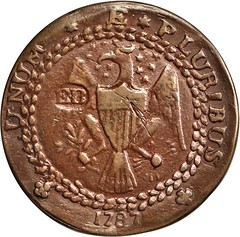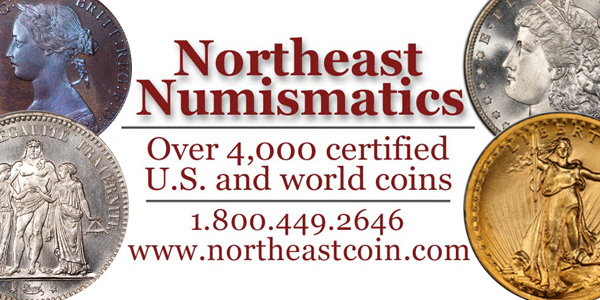
PREV ARTICLE
NEXT ARTICLE
FULL ISSUE
PREV FULL ISSUE
THE 1787 BRASHER DOUBLOON ELECTROTYPECraig Sholley submitted this story about the 1787 Brasher Doubloon Electrotype just auctioned by Stack's Bowers. Thanks! -Editor   The Fantastic Dubois-W. Elliot Woodward Brasher Electrotype Almost buried amongst and certainly overshadowed by the amazing assemblage of colonial and early Federal coinage in the Stack's Bowers October Baltimore sale this past Friday night was a lone electrotype of the famous 1787 Brasher or “New York” Doubloon. The cataloger had described it thusly: 1787 (ca. 1860s?) Brasher Doubloon electrotype. EB on Wing. Copper shells over lead. As a collector of 19th century electro’s, I began researching the piece as soon as my “want-list” search on the Stack's Bowers site notified me it was coming up for sale and despite the fact that it’s a bit out of my collecting area (I’m particularly interested in pieces from Charles Enders, Jr.’s fixed price list from the 1880’s), I put in what I felt was a very strong bid of $5250.00 based on what I had found. Since the title of this small article gives it away, I’ll cut straight to the point. In his April 28 to May 1, 1863 sale W. Elliot Woodward offered lot 2105, “A fine fac-simile of the New York Doubloon, Doubloon, made at the mint by Mr. Dubois.” The piece was purchased by Charles Bushnell for $2.50, but as Saul Teichman noted to me in an email, that piece does not appear in the 1882 sale of his collection, so it was obviously sold or traded some prior date. Woodward subsequently sold another piece in his October 21 to 4, 1863 sale, lot 3061, described as “Copy of the New York Doubloon, a perfect fac simile, made by Mr. Dubois, at the mint, much finer than the one in my last sale.” The piece sold to Joseph Levick for $3.50, who subsequently sold it in his April 1865 sale where it brought but one dollar! So, William Ewing Dubois, the son-in-law of Adam Eckfeldt and Curator of the Mint Cabinet, had, at some point in early 1863, produced two electrotypes of the 1787 Brasher Doubloon in the mint collection and traded hem to Woodward for some unknown pieces for the collection and the piece in the Stack's Bowers sale was, in fact, one of the two as it exactly replicates the centering and scratches seen on the Mint Cabinet piece. Whether this is the “finer” or lesser piece is unknown at this point, but does that really matter as it has one heck of an amazing history? Collectors should be aware that the Dubois-Woodward pieces are definitely not the only electrotypes of Brashers that were available at the time and possibly exist to this day as Woodward sold another piece, not attributed to Dubois, in his October/May 1863 sale for fifty cents. For those who may wonder if the electro might have been made at some point prior to the original piece being pulled from a bullion deposit by Adam, the answer in a word is no. The pieces that would become the Mint Cabinet were turned over by Eckfeldt in June of 1838 and in his 1846 tome “Pledges of History” Dubois notes the doubloon was in the collection at that point. Since the first successful process for electrotyping was not demonstrated until October of 1838 by Mortiz Jacobi at the Russian Academy of Sciences and word of the process had not reached Western Europe and America until the end of that year, it’s obviously impossible for the piece to have been made outside the mint and the piece is thus one of the two traded to Woodward. It should also be noted that the 1838 date many authors and catalogers use for the time period this and other pieces were placed in the collection is based on a misreading of an 1878 recollection by Dubois concerning the founding of the Mint Cabinet with Dubois noting the collection was formed some forty years ago. However, it is clear that Dubois is speaking generally and about the date Adam turned the coins over to the Mint Cabinet, not the date he found the pieces, which in most cases was much earlier. I’ll close with a thank you to Tony Terranova who suggested I send this article to The E-Sylum. AS tony noted, “Every coin geek in the U.S. reads the E-Sylum. Why wouldn’t you send it to Wayne, it’s the perfect place to publish something like this.” Greetings, coin geeks! I hope you enjoyed this as much as I did. Thanks for the great submission, Craig. -Editor  Wayne Homren, Editor The Numismatic Bibliomania Society is a non-profit organization promoting numismatic literature. See our web site at coinbooks.org. To submit items for publication in The E-Sylum, write to the Editor at this address: whomren@gmail.com To subscribe go to: https://my.binhost.com/lists/listinfo/esylum All Rights Reserved. NBS Home Page Contact the NBS webmaster 
|